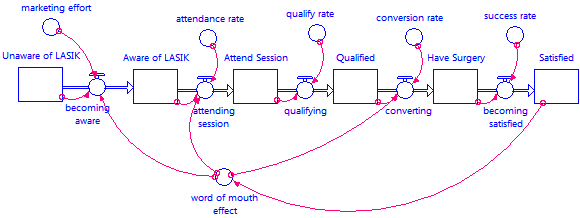Humanities Major Attempts Dynamic Modeling and Survives!
This post is written by Rolf Olsen, a participant in our Introduction to Dynamic Modeling with iThink and STELLA workshop held last month in Colorado Springs. We thought Rolf’s perspective would offer insights for those of you who are new to Systems Thinking or curious about applying dynamic modeling to real-world issues.

I was very excited about a last-minute chance to attend the introductory iThink/STELLA workshop, but to be honest, on the flight to Colorado Springs, I started to become apprehensive. Who was I trying to kid? Sure, I’d heard the terms “stock” and “flow” and I understood their roles as the nouns and verbs of the software. I’d even read a few chapters in Barry Richmond’s Introduction to Systems Thinking. But the first time I started up the software and stared at that blank workspace, I had no clue where to begin! Adding to my anguish, I was quite certain there would be others there who were much smarter than me and really knew what they were doing.
In college I spent most of my time and energy studying English and French, language, literature, cinema, art history, and so forth. I managed to avoid all higher math like the plague (although I did reasonably well in basic statistics). My engineer father often reminded me that my degree in Humanities prepared me for almost nothing. After college, I stumbled into a career in marketing – quite fertile territory for exploring system dynamics and modeling, as it turns out. I spent a few formative years in an ad agency and at a regional banking system, before finding my stride marketing and managing nonprofit arts and culture organizations. Today I work in marketing and communication in a large academic medical center.
For years I’ve used spreadsheets to model various ‘what if’ scenarios. In the arts, I used spreadsheets to create budgets and set ticket prices, always seeking ways to better predict revenue from ticket sales at different prices, for different types of performances (e.g., modern dance, string quartet, jazz ensemble), or on different days of the week.
Preparing for the iThink/STELLA workshop, I decided I’d like to try to model demand in a market area for laser vision correction surgery, popularly known as LASIK or PRK. That seemed simple enough. I might be able to bluff my way through this workshop after all!
In the end, all my concerns and fears of inadequacy were for naught. Corey Peck is a remarkable teacher. Within the first hour of the first day, he’d already explained that almost everybody who starts iThink for the first time takes a deep gulp at the sight of that blank workspace, wondering how to begin. That was comforting, to say the least.
Others in this workshop included a nurse from Nigeria, two men from a large consulting firm that counts the military among its principal clients, three people with separate interests in systems used to deliver electrical energy, two from the IS planning department of a large national insurance company, a woman from an Oregon health care system, and two women from Hong Kong who teach English at a university there. And there was me, the health care marketing geek.
Despite the diversity of our backgrounds and fields of endeavor, somehow, over two and a half days of workshop, Corey always managed to guide and instruct us, as a group and individually, in a way that was neither too complex and esoteric nor too simple. He obviously comprehends dynamic systems so well, and knows the software so thoroughly, that no matter what type of model one of us presented, Corey could quickly offer clear and helpful guidance. I never felt lost, and I always found myself learning something as I eavesdropped on Corey’s conversations with others in the class.
Our other instructor, Mark Paich, was a protégé and colleague of some of the pioneers of Systems Thinking, including Barry Richmond and Peter Senge. Mark’s tales from years of consulting work with clients, such as General Motors, were fascinating and, for me, they helped place the concepts we were exploring within a much larger context. Although the scope and complexity of some of the projects Mark described were daunting, these stories helped me appreciate more clearly what is possible when you begin to view almost any situation you encounter as a dynamic system. And the stories were fascinating and fun, providing an excellent “brain break” from the rigors of our lessons with Corey!
By the end of the first day, we’d all constructed our first working models, and begun to sketch out the models we hoped to build. As I mentioned, I wanted to try to create a simple model to explore dynamic demand, based on several variable factors, for LASIK vision correction surgery. I’d start with the population of our market area and then determine the number of people who wear glasses or contacts.
- Of those people, how many are aware that our hospital offers LASIK surgery?
- How many of the “aware” group might be willing to attend a free information session and preliminary evaluation?
- Of all qualified candidates, how many would be willing and able to actually go through with the surgery?
- Then, after successful LASIK surgery, how many people would tell their friends, neighbors or colleagues how happy they were, thus spreading awareness and influencing a new group of candidates to have LASIK surgery?
- And what might be the impact on surgery volume of marketing efforts at various levels of expenditure? How about a discount or referral incentive?

I started out pretty simply because, as Corey reminded us often, “There’s plenty of time to make it more complex later.” That proved to be great advice. And in the end, I went home with a rudimentary model that seemed to work. Well, mostly. It needs more work and I need more practice. And when I mentioned to Corey that I hoped to figure out how to factor in the “word of mouth” effect into my model, he promised to send me information about the “Bass Diffusion Model” that addresses that very topic. And sure enough, an email arrived a few days after I’d returned home.
In all, my experience at the introductory iThink/STELLA workshop was excellent, even transformative. I now often find myself thinking in terms of stocks, flows, converters and connectors. I don’t literally model every situation I encounter, of course, but I see applications all around me. I know I have an enormous amount yet to learn, the introductory course covered just the basics for me. But now I have more confidence and I feel inspired to move forward, because I’ve had a tantalizing glimpse of what’s possible with a proper grasp of key concepts, the right software tool – and remarkable teachers.